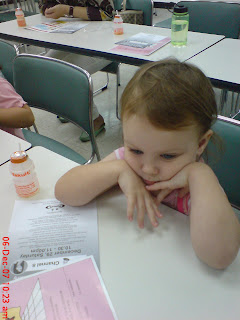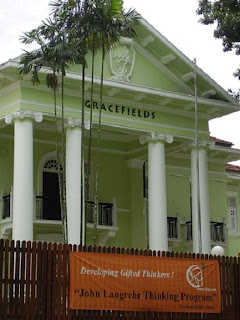Recipe on Tuna Salad
Prep Time: 10 min
Total Time: 10 min
Prep Time: 10 min
Total Time: 10 min
Ingredients:
1 can garbanzo beans (drained and mashed)
2 tablespoons mayonnaise
2 teaspoons spicy brown mustard
1 tablespoon sweet pickle relish
2 green onions (chopped)
salt and pepper (to taste)
Preparation:
In a medium bowl, combine garbanzo beans, mayonnaise, mustard, relish, chopped green onions, salt and pepper.
Mix well.
1 can garbanzo beans (drained and mashed)
2 tablespoons mayonnaise
2 teaspoons spicy brown mustard
1 tablespoon sweet pickle relish
2 green onions (chopped)
salt and pepper (to taste)
Preparation:
In a medium bowl, combine garbanzo beans, mayonnaise, mustard, relish, chopped green onions, salt and pepper.
Mix well.
*********************************************************
Children at Work
Children at Work

Charis

Julian

Samuel

Elijah

Issac

Xin Hui

Faithe

Dillon

Ashley

Allan

Miah

Kajsa
*********************************************************
For Parents:
Isn't it a little challenging to get young children to eat their greens during meals? This recipe could be just do the trick!
Tuna salad is not only easy to make, but it is definitely yummy and healthy to eat. The photos of the children mixing their tuna salad illustrated how much they had enjoyed this cooking experience! Parents are most welcomed to give it a try at home with their children too!
Cheers,
Angeline
Isn't it a little challenging to get young children to eat their greens during meals? This recipe could be just do the trick!
Tuna salad is not only easy to make, but it is definitely yummy and healthy to eat. The photos of the children mixing their tuna salad illustrated how much they had enjoyed this cooking experience! Parents are most welcomed to give it a try at home with their children too!
Cheers,
Angeline
 The guide was bringing the children to see the "Arowana".
The guide was bringing the children to see the "Arowana". The children were looking at different species of fishes in the aquarium.
The children were looking at different species of fishes in the aquarium. The guide was explaining how they export fishes to other countries.
The guide was explaining how they export fishes to other countries. The guide was explaining how the fish farm rears "Arowana" in the ponds.
The guide was explaining how the fish farm rears "Arowana" in the ponds. Miah & Kajsa were taking care of each other.
Miah & Kajsa were taking care of each other. The children were admiring the beautiful "Kois".
The children were admiring the beautiful "Kois". Julian
Julian Elijah & Issac
Elijah & Issac Samuel
Samuel Miranda & Elizabeth
Miranda & Elizabeth Dillon
Dillon Xin Hui, Faithe & Charis
Xin Hui, Faithe & Charis Elijah
Elijah Miah
Miah Emily
Emily Wen Pei
Wen Pei Allan
Allan Dillon
Dillon Ashley
Ashley Elijah
Elijah Miah
Miah Kajsa
Kajsa Issac
Issac Skincare Products
Skincare Products Other Products
Other Products Yakult packaging from different countries
Yakult packaging from different countries Allan, Elizabeth, Miranda & Shaun
Allan, Elizabeth, Miranda & Shaun Shaun & Dillon
Shaun & Dillon Elizabeth & Miranda
Elizabeth & Miranda Miah, Alix, Issac & Allan
Miah, Alix, Issac & Allan Group A
Group A Group B
Group B Bacteria under the mircoscope
Bacteria under the mircoscope The guide was showing the children a picture of Mr Shirota.
The guide was showing the children a picture of Mr Shirota. The guide was explaining the different types of good bacteria to the children.
The guide was explaining the different types of good bacteria to the children. Elizabeth
Elizabeth Miranda
Miranda Emily
Emily
 Shu Yi
Shu Yi Wen Pei
Wen Pei Miah
Miah Kajsa
Kajsa Ashley
Ashley Dillon
Dillon Shaun
Shaun Julian
Julian